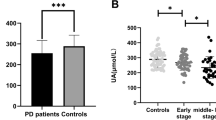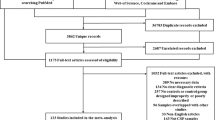Abstract
Objective
Neuron-specific enolase (NSE) has been suggested for demonstrating brain metabolism in neuropsychiatric disorders. This study assessed serum NSE levels in patients with tic disorders (TD).
Methods
In this retrospective case-control study, we investigated whether NSE levels were increased in TD patients. Then, the influencing factors and correlations between NSE levels and clinical features were analyzed. Finally, we tested its diagnostic value for identifying tic severity.
Results
NSE levels were increased in TD patients, although no statistically significant difference was present between transient TD, chronic TD, and Tourette syndrome. Factors influencing NSE levels assessed by multiple linear regression were the Yale Global Tic Severity Scale (YGTSS) global severity scores and gender. There were significant correlations between NSE levels and tic severity. The optimal cut-off value to distinguish mild tics from moderate-severe tics estimated by receiver operating characteristics curve was 24.95 ng/ml (AUC = 0.683).
Conclusion
Our findings suggested that NSE may be a significant biomarker in TD but should be confirmed in further investigation.


Similar content being viewed by others
References
American Psychiatric Association (2013) The Diagnostic and Statistical Manual of Mental Disorders (5th ed.;DSM-5). American Psychiatric Association, Arlington
Bloch MH, Peterson BS, Scahill L, Otka J, Katsovich L, Zhang H, Leckman JF (2006) Adulthood outcome of tic and obsessive compulsive symptom severity in children with Tourette syndrome. Arch Pediatr Adolesc Med 160:65–69
McNaught KSP, Mink JW (2011) Advances in understanding and treatment of Tourette syndrome. Nat Rev Neurol 7:667–676
Silvestri PR, Chiarotti F, Baglioni V, Neri V, Cardona F, Cavanna AE (2016) Health-related quality of life in patients with Gilles de la Tourette syndrome at the transition between adolescence and adulthood. Neurol Sci 37:1857–1860
Cavanna AE, David K, Bandera V, Termine C, Balottin U, Schrag A, Selai C (2013) Health-related quality of life in Gilles de la Tourette syndrome: a decade of research. Behav Neurol 27:83–93
Felling RJ, Singer HS (2011) Neurobiology of Tourette syndrome: current status and need for further investigation. J Neurosci 31(35):12387–12395
Eyre H, Baune BT (2012) Neuroplastic changes in depression: a role for the immune system. Psychoneuroendocrinology 37:1397–1416
Wiener CD, Jansen K, Ghisleni G, Kaster MP, Souza LD, Lara DR, Portela LV, da Silva RA, Oses JP (2013) Reduced serum levels of neuron specific enolase (NSE) in drug-naive subjects with major depression and bipolar disorder. Neurochem Res 38:1394–1398
Busnello JV, Leke R, Oses JP, Feier G, Bruch R, Quevedo J, Kapczinski F, Souza DO, Cruz Portela LV (2006) Acute and chronic electroconvulsive shock in rats:effects on peripheral markers of neuronal injury and glial activity. Life Sci 78:3013–3017
Machado-Vieira R, Andreazza AC, Viale CI, Zanatto V, Cereser V Jr, daSilva Vargas R et al (2007) Oxidative stress parameters in unmedicated and treated bipolar subjects during initial manic episode: a possible role for lithiumantioxidant effects. Neurosci Lett 421:33–36
Brandel JP, Beaudry P, Delasnerie-Lauprêtre N, Laplanche JL (1999) Creutzfeldt-Jakob disease: diagnostic value of protein14-3-3 and neuronal specific enolase assay in cerebrospinal fluid. Rev Neurol (Paris) 155:148–151
Guzel A, Er U, Tatli M, Aluclu U, Ozkan U, Duzenli Y, Satici O, Guzel E, Kemaloglu S, Ceviz A, Kaplan A (2008) Serum neuron-specific enolase as a predictor of short-term outcome and its correlation with Glasgow Coma Scale in traumatic brain injury. Neurosurg Rev 31:439–444
Hamed SA, Eltayeb AA, Mohamad HO, Moussa EM (2013) Brain function in children with uncomplicated epilepsy: relationship to biomarkers of brain damage (neuron specific enolase and S100bprotein). J Pediatr Epilepsy 2:115–124
Gonzalez-Garcia S, Gonzalez-Quevedo A, Fernandez-Concepcion O, Pena-Sanchez M, Menendez-Sainz C et al (2012) Short-term prognostic value of serum neuron specific enolase and S100B in acute stroke patients. Clin Biochem 45:1302–1307
Cronberg T, Rundgren M, Westhall E, Englund E, Siemund R, Rosen I, Widner H, Friberg H (2011) Neuron-specific enolase correlates with other prognostic markers after cardiac arrest. Neurology 77:623–630
Hawro T, Bogucki A, Krupińska-Kun M, Maurer M, Woźniacka A (2015) Serum neuron specific enolase-a novel indicator for neuropsychiatric systemic lupus erythematosus? Lupus 24:1492–1497
Singer HS, Butler IJ, Tune LE, Seifert WE Jr, Coyle JT (1982) Dopaminergic dysfunction in Tourette syndrome. Ann Neurol 12:361–366
Tinaz S, Belluscio BA, Malone P, van der Veen JW, Hallett M, Horovitz SG (2014) Role of the sensorimotor cortex in Tourette syndrome using multimodal imaging. Hum Brain Mapp 35:5834–5846
Kanaan AS, Gerasch S, García-García I, Lampe L, Pampel A, Anwander A, Near J, Harald EM, Mller-Vahl K (2017) Pathological glutamatergic neurotransmission in Gilles de la Tourette syndrome. Brain 140:218–234
Corbett BA, Mendoza SP, Baym CL, Bunge SA, Levine S (2008) Examining cortisol rhythmicity and responsivity to stress in children with Tourette syndrome. Psychoneuroendocrinology 33(6):810–820
Chappell P, Riddle M, Anderson G, Scahill L, Hardin M, Walker D, Cohen D, Leckman J (1994) Enhanced stress responsivity of Tourette syndrome patients undergoing lumbar puncture. Biol Psychiatry 36(1):35–43
Author information
Authors and Affiliations
Contributions
Authors Juanjuan Hao and Min Wu designed the study, collected and analyzed the data, and wrote the manuscript. Authors Xin Zhang and Keyu Jiang made a contribution on revising the manuscript for content. All authors approved the final manuscript.
Corresponding author
Ethics declarations
Conflict of interest
The authors declare that they have no conflict of interest.
Ethical approval
This study was approved by the Xinhua Hospital Ethics Committee affiliated to Shanghai JiaoTong University School of Medicine (Approval No. XHEC-D-2018-047).
Additional information
Publisher’s note
Springer Nature remains neutral with regard to jurisdictional claims in published maps and institutional affiliations.
Rights and permissions
About this article
Cite this article
Hao, J., Zhang, X., Jiang, K. et al. New insights into the role of neuron-specific enolase in tic disorders. Neurol Sci 40, 1167–1172 (2019). https://doi.org/10.1007/s10072-019-03811-9
Received:
Accepted:
Published:
Issue Date:
DOI: https://doi.org/10.1007/s10072-019-03811-9




